Utilisateur:Laura Conant
De Design numérique
Scan to OCR
Comment une machine peut-elle reconnaître du texte
Traitement d'un PDF avec Tesseract
Scans et sortie du texte
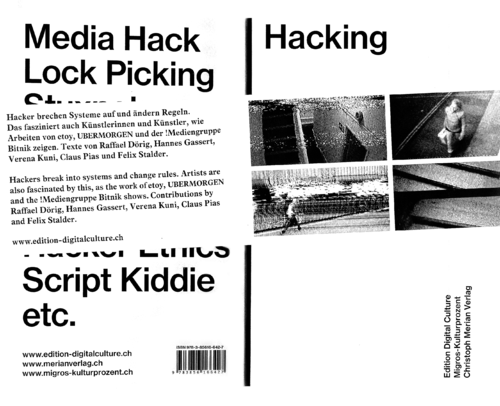

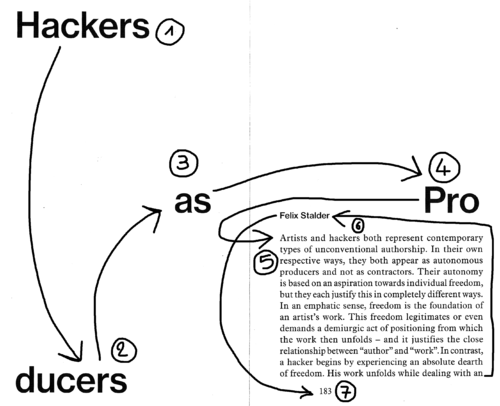
→ Sens de lecture opéré par Tesseract sur le document pdf.
Hackers ducers as Pro Artists and hackers both represent contemporary types of unconventional authorship. In their own respective ways, they both appear as autonomous producers and not as contractors. Their autonomy is based on an aspiration towards individual freedom, but they each justify this in completely different ways. In an emphatic sense, freedom is the foundation of an artist’s work. This freedom legitimates or even demands a demiurgic act of positioning from which the work then unfolds — and it justifies the close relationship between “author” and “work”. In contrast, a hacker begins by experiencing an absolute dearth of freedom. His work unfolds while dealing with an Felix Stalder 183
Texte entier tout pdf combinés : omnipotent system! in which all options for action are predetermined. The hacker’s goal is to seize hold of moments of freedom anyway. “Artists” and “hackers” are ideal types here, conceptual abstractions. They were formed to make certain contexts more tangible. In the following, the focus will be directed towards the relationship be- tween respective notions of freedom and social mecha- nisms functioning within regimes of order. The assumption that artists begin from a posi- tion of complete freedom is a historical development as a part of liberal concepts of freedom: Every man is born in liberty, which is finally expressed by the stew- ardship rights he has for his own body.’ This freedom legitimates private property, understood as the fruits of the labor performed by one’s own body. This con- cept is directed against old forms of serfdom, bonded labor and arbitrary disenfranchisement or taxation. It re-oriented society away from the distribution of goods based on privilege bestowed by a sovereign and towards the production of goods by entrepreneurs; their objectives were thus moved to the center of society’s agenda. This concept of freedom as the point of foundation for social interaction was essential for the liberal understanding of the interrelated catego- ries “individual” and “private property”. 1 Systems are integrated contexts of function. What functioning is can be determined technically, culturally or institutionally. 2 John Locke’s (1632-1704) formulation of individual freedom as determined by the stewardship over one’s own body is conceived of from a clearly male perspective. Self-determination of a female body is still, even in liberal societies, a question of debate. 184 In this cosmos, the artist represents the most radically expressed form of an individual’s civil liberty. This entity is then doubly privileged by the legal order: on the one hand, by the legal establishment of the freedom of art, which guarantees the artist’s freedom to work;? on the other hand, by copyright law. This allows him to enforce the claim of understanding his work to be the product of his labor alone, and there- fore his exclusive property. Historically, this allowed the artist to exit from a dependency on commission- ing entities and to engage an audience from an equal position. It was an emancipatory act, no doubt. So _ far, so good. The clarity of these findings, as the political scientist Christian Schmidt notes, “is disturbed by the regime of property’s propensity to expand its area of applicability”.* The property concept’s prerequi- sites become problematic to the degree that forms of ideas and free will become subject to capitalist pro- duction, such as when youth culture is transformed into products. The consequences of this expansion are that “the clear separation between people and property, or put differently, people’s autonomy is questioned”.° If a person constitutes himself or herself as the sole active author, then others are forced into the role of being a passive audience. As long as this is only done 3 Art. 21 of the Federal Constitution of the Swiss Confederation determines: “The freedom of art is guaranteed.” 4 Schmidt, Christian: Individualitat und Eigentum. Zur Rekonstruktion zweier Grundbegriffe der Moderne. Frankfurt am Main 2006, p. 13. 5 Ibid., p. 107. 185 �Media Hack Lock Picking Cb. ----— — 5 Hacker brechen Systeme auf und andern Regeln. niert auch Kiinstlerinnen und Kiinstler, wie Arbeiten von etoy, UBERMORGEN und der IMediengruppe Bitnik zeigen. Texte von Raffael Dérig, Hannes Gassert, Verena Kuni, Claus Pias und Felix Stalder. Das faszi stems and change rules. Artists are as the work ofetoy, UBERMORGEN tnik shows. Contributions by ert, Verena Kuni, Claus Pias Hackers break into sy also fascinated by this, and the !Mediengruppe Bi Raffael Dérig, Hannes Gass and Felix Stalder. www.edition- digitalculture.ch eww Ee LEIS Script Kiddie etc. www.edition-digitalculture.ch | l | | il
Poster 1
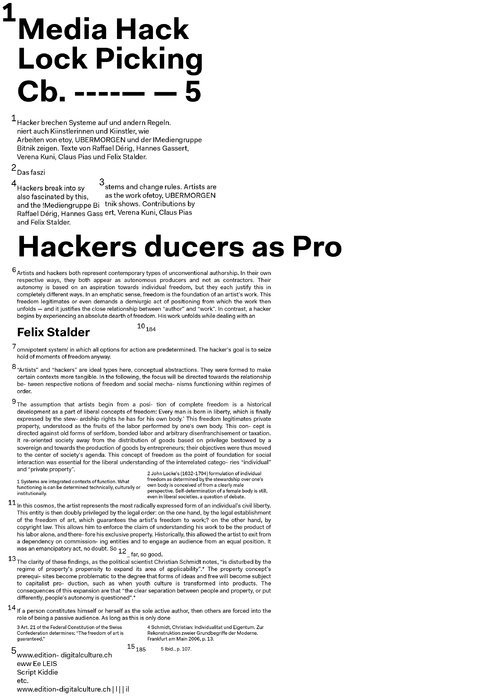
→ Mise en évidence du sens de lecture de Tesseract

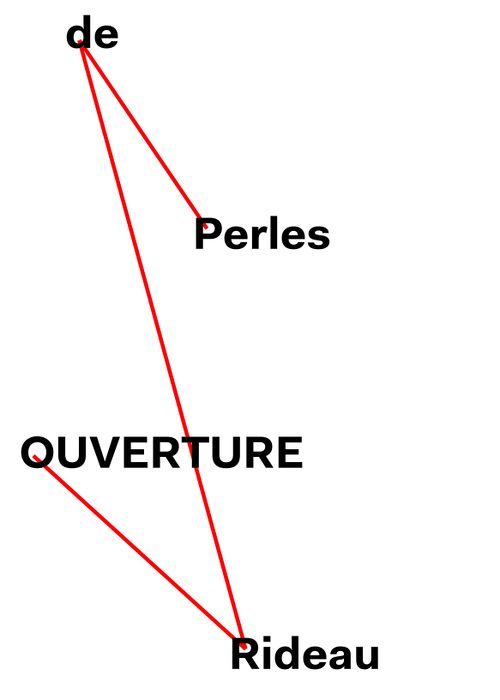
Poster 2
<!DOCTYPE html>
<html lang="en">
<meta charset="utf-8">
<head>
<link rel="stylesheet" href="style2.css">
</head>
<body>
<section data-type="page">
<section id="line">
<svg height="210" width="500">
<line x1="" y1="0" x2="240" y2="0" style="stroke:rgb(255, 0, 0);stroke-width:8" />
</svg>
</section>
<section id="line">
<svg height="210" width="500">
<line x1="150" y1="120" x2="240" y2="0" style="stroke:rgb(255,0,0);stroke-width:4" />
</svg>
</section>
<section id="line">
<svg height="210" width="500">
<line x1="150" y1="120" x2="149" y2="195" style="stroke:rgb(255,0,0);stroke-width:4" />
</svg>
</section>
<section id="line">
<svg height="210" width="500">
<line x1="150" y1="195" x2="-30000" y2="200" style="stroke:rgb(255,0,0);stroke-width:4" />
</svg>
</section>
<section id="line">
<svg height="210" width="500">
<line x1="243" y1="120" x2="240" y2="188" style="stroke:rgb(255,0,0);stroke-width:4" />
</svg>
</section>
<section id="line3">
<svg height="500" width="700">
<line x1="60" y1="230" x2="370" y2="373" style="stroke:rgb(255,0,0);stroke-width:4" />
</svg>
</section>
<section id="line2">
<svg height="300" width="600">
<line x1="1" y1="13" x2="241" y2="6" style="stroke:rgb(255,0,0);stroke-width:4" />
</svg>
</section>
<section id="line3">
<svg height="500" width="700">
<line x1="60" y1="230" x2="30" y2="483" style="stroke:rgb(255,0,0);stroke-width:4" />
</svg>
</section>
<section id="line4">
<svg height="500" width="700">
<line x1="4" y1="8" x2="1" y2="105" style="stroke:rgb(255,0,0);stroke-width:4" />
</svg>
</section>
<section id="line5">
<svg height="500" width="700">
<line x1="27" y1="8" x2="1" y2="65" style="stroke:rgb(255,0,0);stroke-width:4" />
</svg>
</section>
<section id="line5">
<svg height="500" width="700">
<line x1="280" y1="220" x2="1" y2="65" style="stroke:rgb(255,0,0);stroke-width:4" />
</svg>
</section>
<section id="line5">
<svg height="500" width="700">
<line x1="280" y1="220" x2="1" y2="238" style="stroke:rgb(255,0,0);stroke-width:4" />
</svg>
</section>
<section id="line5">
<svg height="600" width="700">
<line x1="1" y1="550" x2="1" y2="238" style="stroke:rgb(255,0,0);stroke-width:6" />
</svg>
</section>
<section id="line5">
<svg height="700" width="700">
<line x1="1" y1="550" x2="248" y2="660" style="stroke:rgb(255,0,0);stroke-width:4" />
</svg>
</section>
<section id="line5">
<svg height="700" width="700">
<line x1="1" y1="670" x2="248" y2="660" style="stroke:rgb(255,0,0);stroke-width:4" />
</svg>
</section>
<section id="line5">
<svg height="800" width="700">
<line x1="1" y1="670" x2="1" y2="700" style="stroke:rgb(255,0,0);stroke-width:6" />
</svg>
</section>
<section id="line6">
<svg height="700" width="700">
<line x1="1" y1="280" x2="1" y2="150" style="stroke:rgb(255,0,0);stroke-width:6" />
</svg>
</section>
<section id="line6">
<svg height="700" width="700">
<line x1="10" y1="290" x2="1" y2="280" style="stroke:rgb(255,0,0);stroke-width:4" />
</svg>
</section>
<section id="line6">
<svg height="700" width="700">
<line x1="10" y1="290" x2="280" y2="295" style="stroke:rgb(255,0,0);stroke-width:4" />
</svg>
</section>
<section id="line6">
<svg height="700" width="700">
<line x1="1" y1="340" x2="280" y2="295" style="stroke:rgb(255,0,0);stroke-width:4" />
</svg>
</section>
<section id="line6">
<svg height="700" width="700">
<line x1="1" y1="340" x2="255" y2="385" style="stroke:rgb(255,0,0);stroke-width:4" />
</svg>
</section>
<h1 class="h1" id="Media">
Media Hack<br>
Cb. ----— — 5<br>
Lock Picking
</h1>
<p class="p" id="order1">
Hacker brechen Systeme auf und andern Regeln.<br>
niert auch Kiinstlerinnen und Kiinstler, wie<br>
Arbeiten von etoy, UBERMORGEN und der IMediengruppe<br>
Bitnik zeigen. Texte von Raffael Dérig, Hannes Gassert,<br>
Verena Kuni, Claus Pias und Felix Stalder.<br>
</p>
<p class="p" id="order2">
Das faszi
</p>
<p class="p" id="order3">
stems and change rules. Artists are<br>
as the work ofetoy, UBERMORGEN<br>
tnik shows. Contributions by<br>
ert, Verena Kuni, Claus Pias<br>
</p>
<p class="p" id="order4">
Hackers break into sy<br>
also fascinated by this,<br>
and the !Mediengruppe Bi<br>
Raffael Dérig, Hannes Gass<br>
and Felix Stalder.<br>
</p>
<p class="p" id="order5">
www.edition- digitalculture.ch<br>
eww Ee LEIS<br>
Script Kiddie<br>
etc.<br>
www.edition-digitalculture.ch | l | | il<br>
</p>
<h1 class="h1"id="hackers">
Hackers
</h1>
<h1 class="h1" id="ducers">
ducers
</h1>
<h1 class="h1" id="as">
as
</h1>
<h1 class="h1" id="pro">
Pro
</h1>
<p class="p" id="order6">
Artists and hackers both represent contemporary
types of unconventional authorship. In their own
respective ways, they both appear as autonomous
producers and not as contractors. Their autonomy
is based on an aspiration towards individual freedom,
but they each justify this in completely different ways.
In an emphatic sense, freedom is the foundation of
an artist’s work. This freedom legitimates or even
demands a demiurgic act of positioning from which
the work then unfolds — and it justifies the close
relationship between “author” and “work”. In contrast,
a hacker begins by experiencing an absolute dearth
of freedom. His work unfolds while dealing with an
</p>
<h3 class="h3" id="felix">
Felix Stalder
</h3>
<p class="p" id="order7">
omnipotent system<span data-ref="1">!</span> in which all options for action
are predetermined. The hacker’s goal is to seize hold
of moments of freedom anyway.
</p>
<p class="p" id="order8">
“Artists” and “hackers” are ideal types here,
conceptual abstractions. They were formed to make
certain contexts more tangible. In the following, the
focus will be directed towards the relationship be-
tween respective notions of freedom and social mecha-
nisms functioning within regimes of order.
</p>
<p class="p" id="order9">
The assumption that artists begin from a posi-
tion of complete freedom is a historical development
as a part of liberal concepts of freedom: Every man is
born in liberty, which is finally expressed by the stew-
ardship rights he has for his own body.<span data-ref="2">’</span> This freedom
legitimates private property, understood as the fruits
of the labor performed by one’s own body. This con-
cept is directed against old forms of serfdom, bonded
labor and arbitrary disenfranchisement or taxation.
It re-oriented society away from the distribution of
goods based on privilege bestowed by a sovereign and
towards the production of goods by entrepreneurs;
their objectives were thus moved to the center of
society’s agenda. This concept of freedom as the point
of foundation for social interaction was essential for
the liberal understanding of the interrelated catego-
ries “individual” and “private property”.
</p>
<footer class="footer" id="footer1">
1 Systems are integrated contexts of function. What functioning is
can be determined technically, culturally or institutionally.
</footer>
<footer class="footer" id="footer2">
<span data-ref="2">2</span> John Locke’s (1632-1704) formulation of individual freedom as
determined by the stewardship over one’s own body is conceived of
from a clearly male perspective. Self-determination of a female body
is still, even in liberal societies, a question of debate.
</footer>
<p class="p" id="order10">
184
</p>
<p class="p" id="order11">
In this cosmos, the artist represents the most radically
expressed form of an individual’s civil liberty. This
entity is then doubly privileged by the legal order:
on the one hand, by the legal establishment of the
freedom of art, which guarantees the artist’s freedom
to work;<span data-ref="3">?</span> on the other hand, by copyright law. This
allows him to enforce the claim of understanding his
work to be the product of his labor alone, and there-
fore his exclusive property. Historically, this allowed
the artist to exit from a dependency on commission-
ing entities and to engage an audience from an equal
position. It was an emancipatory act, no doubt. So
</p>
<p class="p" id="order12">
_ far, so good.
</p>
<p class="p" id="order13">
The clarity of these findings, as the political
scientist Christian Schmidt notes, “is disturbed by
the regime of property’s propensity to expand its area
of applicability”.<span data-ref="4">*</span> The property concept’s prerequi-
sites become problematic to the degree that forms of
ideas and free will become subject to capitalist pro-
duction, such as when youth culture is transformed
into products. The consequences of this expansion
are that “the clear separation between people and
property, or put differently, people’s autonomy is
questioned”.<span data-ref="5">°</span>
</p>
<p class="p" id="order14">
If a person constitutes himself or herself as the
sole active author, then others are forced into the role
of being a passive audience. As long as this is only done
</p>
<p class="p" id="order15">
185
</p>
</section>
</body>�
</html>
@font-face{
font-family: 'Fakt';
src: url('fonts/FaktPro-Normal.otf');
font-weight: normal;
font-style: normal;
}
@font-face{
font-family: 'Fakt';
src: url('fonts/FaktPro-Bold.otf');
font-weight: bold;
font-style: normal;
}
html, body{
margin:0;
padding:0;
}
h1{
font-family: 'Fakt';
font-size: 50pt;
color:black;
margin:0;
line-height: 50pt;
}
h2{
font-family: 'Fakt';
color:black;
font-size:50pt;
margin:0;
}
h3{
font-family: 'Fakt';
color:black;
font-size:20pt;
margin:0;
}
footer{
font-family: 'Fakt';
font-size: 8pt;
color:black;
margin:0;
width: 70mm;
}
p{
position:relative;
font-size:10pt;
}
section[data-type="page"]{
width:297mm;
height:500mm;
position: relative;
padding:10mm;
box-sizing: border-box;
}
#Media{
position:absolute;
top:1mm;
font-size:70pt;
line-height: 20mm;
}
#felix{
position:absolute;
top:160mm;
}
#order1 {
position:absolute;
top:131mm;
font-family: 'Fakt';
line-height: normal;
color:black;
width: 14cm;
}
#order2 {
position:absolute;
top:60mm;
font-family: 'Fakt';
color:black;
width: 14mm;
}
#order3 {
font-family: 'Fakt';
color:black;
width: 66mm;
position: absolute;
top:66mm;
left:110mm;
}
#order4 {
position:absolute;
top:66mm;
font-family: 'Fakt';
color:black;
width: 65mm;
}
#order5 {
font-family: 'Fakt';
color:black;
width:74mm;
position: absolute;
top:388mm;
}
#order6 {
position: absolute;
top:170mm;
font-family: 'Fakt';
color:black;
text-align:justify;
width: 15cm;
}
#order7 {
position: absolute;
top:215mm;
font-family: 'Fakt';
color:black;
text-align:justify;
width: 15cm;
}
#order8 {
position: absolute;
top: 228mm;
font-family: 'Fakt';
color:black;
text-align:justify;
width: 15cm;
}
#order9 {
position: absolute;
top:248mm;
font-family: 'Fakt';
color:black;
text-align:justify;
width: 15cm;
}
#order10 {
font-family: 'Fakt';
color:black;
width:8mm;
position:absolute;
top:208mm;
left:29%;
}
#order11 {
position: absolute;
top:295mm;
font-family: 'Fakt';
color:black;
text-align:justify;
width: 15cm;
}
#order12 {
position: absolute;
font-family: 'Fakt';
color:black;
left:75mm;
top:325mm;
position:absolute;
width: 15cm;
}
#order13 {
position: absolute;
top:330mm;
font-family: 'Fakt';
color:black;
text-align:justify;
width: 15cm;
}
#order14 {
position: absolute;
top:360mm;
font-family: 'Fakt';
color:black;
text-align:justify;
width: 15cm;
}
#order15 {
font-family: 'Fakt';
color:black;
width:8mm;
width: 15cm;
position: absolute;
top:397mm;
left: 27%;
}
#footer1{
font-family: 'Fakt';
position:absolute;
top:377mm;
color:black;
}
#footer2{
font-family: 'Fakt';
color:black;
position:absolute;
left:87mm;
top:377mm;
}
#footer3{
font-family: 'Fakt';
color:black;
position:absolute;
left:10mm;
bottom:41mm;
}
#footer4{
font-family: 'Fakt';
color:black;
position:absolute;
left:87mm;
bottom:41mm;
}
#footer5{
font-family: 'Fakt';
color:black;
position:absolute;
left:95mm;
bottom:35mm;
}
#ducers{
position: absolute;
margin-left: 10cm;
top:95mm;
}
#pro{
position: absolute;
margin-left: 10cm;
top:115mm;
}
#hackers{
position: absolute;
top:95mm;
}
#as{
position: absolute;
top:115mm;
left:2cm;
}
#line{
position: absolute;
top:10mm;
left:10mm;
}
Lecture par la machine
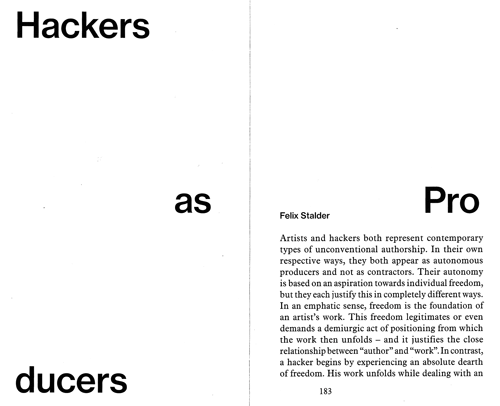
2EME SEMESTRE
QUESTIONNER LA NAVIGATION DANS LE TEXTE DANS L'ESPACE NUMERIQUE
Une interface de lecture
Nous avons créer en cours une bibliothèque pirate à l'aide de nos RaspberryPi.
La question de l'interface se pose maintenant. Comment naviguer à travers les textes, dans le texte ?
Généralement, les bibliothèque en ligne propose le téléchargement de pdf, ou epub reprennent exactement la mise en page d'un livre physique.
Or, la lecture sur un appareil numérique s'appréhende de manière différente de celle d'un livre physique.
Notre contrat de lecture de la réalité est redéfini à travers l'espace numérique. Cela implique de trouver de nouvelles façons d'aborder la lecture en ligne. Ce projet est une réflexion plastique, poétique et pratique comme sur la façon de se situer dans un flux de texte, sans la référence folio d'un livre.
Un nouveau contrat de lecture
"Un livre n’est pas qu’un objet, il est surtout une accumulation de conventions qui aident à lire : le repérage dans le livre par les pages d’entrée, de seuil, la table des matières, le découpage du texte en chapitres, en paragraphes ; mais aussi le repérage dans la page avec le titre courant, la justification de la colonne de texte, le choix du caractère, la ponctuation. Ces différents modes de repérage font la fluidité de la lecture." (La lecture numérique : réalités, enjeux et perspectives, Claire Bélisle, Presses de l'ENSSIB, 2004)
Yves Jeanneret et Emmanuel Souchier affirment quant à eux qu'avec la lecture numérique, « les conditions de manipulation du texte ont changé. Face à la machine, le lecteur est placé dans une situation paradoxale de distanciation et d'engagement. La distance de l'homme à la machine est plus grande que celle de l'homme au livre, car le texte semble avoir disparu "derrière" l'écran, laissant prise à l'espace du secret et du sacré. En revanche, l'engagement physique s'accroît, car le lecteur devient manipulateur et doit "agir" la machine à des fins purement fonctionnelles.» (« Pour une poétique de "l'écrit d'écran" », Xoana, no 6, 1999) Ainsi, le lecteur peut agir et ou interagir tout au long de son parcours de lecture.
Une autre particularité de la lecture numérique réside dans la nature activable de certains signes. Les auteurs parlent de « dimension manipulatoire » de la lecture qui sert de guide de parcours au lecteur. Cela lui permet de s'orienter dans l'espace dynamique en construisant son propre espace documentaire précis, mais toujours ouvert à de nouveaux parcours. L'appropriation du texte passe davantage par la manipulation du texte que sur support imprimé.
Contenu de l'interface
J'ai eu l'occasion au cours de l'année de lire beaucoup de textes pour mes divers projets.
Mis ensemble, quant à ma pratique de cette année, qui est le lien entre tous pour moi.
Quelques exemples de textes :
Lost Dimension, Paul Virilio
Identités Virtuelles, Fanny Georges
The Internet Does not Exist, E-FLux
Museums at the Post-Digital Turn, Mousse-Publishing
Lingistic Capitalism, Frederic Kaplan
...
Premier temps
Les premières expérimentations tiennent plus de l'expérimentation plastique sur l'affichage et la lecture d'un texte en ligne.
Second temps
Je me suis ensuite plus intéressée à une navigation dans le texte de manière "utilitaire", comment se retrouver dans le texte, quel est notre temps de lecture restant?
3ème temps
Mise en place d'une interface présentant toutes les expérimentations: http://lauraconant.be/pratiquesnumeriques/